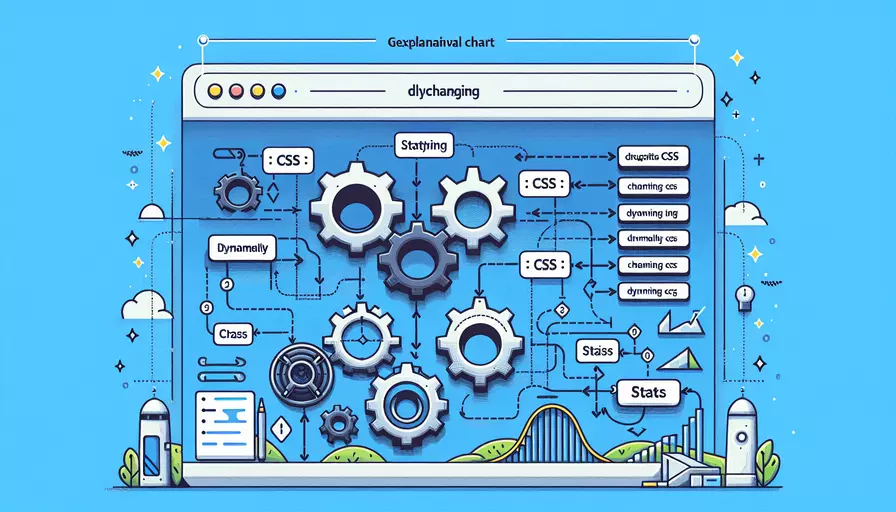
要在Vue中动态地改变CSS,你可以使用以下几种方法:1、绑定内联样式,2、绑定类名,3、使用计算属性。接下来我们会详细讲解这些方法,并提供一些示例代码以供参考。
一、绑定内联样式
Vue允许你通过 v-bind 指令或者简写 : 来绑定内联样式。这是一个非常直接的方法,适用于样式需要频繁变化的场景。
<template>
<div :style="dynamicStyle">This is a div with dynamic styles</div>
<button @click="changeStyle">Change Style</button>
</template>
<script>
export default {
data() {
return {
dynamicStyle: {
color: 'red',
fontSize: '14px'
}
}
},
methods: {
changeStyle() {
this.dynamicStyle.color = this.dynamicStyle.color === 'red' ? 'blue' : 'red';
this.dynamicStyle.fontSize = this.dynamicStyle.fontSize === '14px' ? '20px' : '14px';
}
}
}
</script>
二、绑定类名
绑定类名是一种更可维护的方法,特别是当你有多个样式需要动态改变时。你可以使用对象语法或数组语法来绑定类名。
<template>
<div :class="{'active': isActive, 'text-large': isLarge}">This is a div with dynamic classes</div>
<button @click="toggleClass">Toggle Class</button>
</template>
<script>
export default {
data() {
return {
isActive: false,
isLarge: false
}
},
methods: {
toggleClass() {
this.isActive = !this.isActive;
this.isLarge = !this.isLarge;
}
}
}
</script>
<style>
.active {
background-color: yellow;
}
.text-large {
font-size: 20px;
}
</style>
三、使用计算属性
你还可以通过计算属性来动态地计算和应用样式。这种方法可以使你的代码更加简洁和易于维护。
<template>
<div :class="computedClass">This is a div with computed classes</div>
<button @click="toggleClass">Toggle Class</button>
</template>
<script>
export default {
data() {
return {
isActive: false,
isLarge: false
}
},
computed: {
computedClass() {
return {
'active': this.isActive,
'text-large': this.isLarge
}
}
},
methods: {
toggleClass() {
this.isActive = !this.isActive;
this.isLarge = !this.isLarge;
}
}
}
</script>
<style>
.active {
background-color: yellow;
}
.text-large {
font-size: 20px;
}
</style>
四、动态切换主题
在实际项目中,可能需要根据用户的操作或设置动态切换整个应用的主题。可以通过Vue的响应式数据和CSS变量来实现。
<template>
<div :class="themeClass">This is a div with dynamic theme</div>
<button @click="toggleTheme">Toggle Theme</button>
</template>
<script>
export default {
data() {
return {
isDarkTheme: false
}
},
computed: {
themeClass() {
return this.isDarkTheme ? 'dark-theme' : 'light-theme';
}
},
methods: {
toggleTheme() {
this.isDarkTheme = !this.isDarkTheme;
}
}
}
</script>
<style>
.light-theme {
--bg-color: white;
--text-color: black;
}
.dark-theme {
--bg-color: black;
--text-color: white;
}
div {
background-color: var(--bg-color);
color: var(--text-color);
}
</style>
五、使用外部库
在更复杂的项目中,可能需要使用一些外部库来管理样式,比如 Vue Styled Components 或者 Sass。这些工具可以提供更强大的样式管理功能,使你的代码更加模块化和可维护。
<template>
<StyledDiv>Styled using Vue Styled Components</StyledDiv>
</template>
<script>
import styled from 'vue-styled-components';
const StyledDiv = styled.div`
color: ${props => props.primary ? 'blue' : 'red'};
font-size: 20px;
`;
export default {
components: {
StyledDiv
}
}
</script>
总结一下,在Vue中动态改变CSS可以通过1、绑定内联样式,2、绑定类名,3、使用计算属性等多种方法实现。根据具体需求选择合适的方法,可以使你的代码更加简洁和易于维护。如果需要更复杂的样式管理,可以考虑使用外部库。希望这些方法和示例能帮助你更好地理解和应用动态CSS的技巧。
相关问答FAQs:
1. 如何在Vue中动态改变CSS样式?
在Vue中,可以通过绑定CSS类名或内联样式的方式来实现动态改变CSS。以下是一些常用的方法:
- 使用动态类名绑定:通过在元素上使用v-bind绑定class属性,可以根据组件的状态或数据来动态添加或删除类名。例如:
<template>
<div :class="{'active': isActive, 'highlight': isHighlighted}">动态样式</div>
</template>
<script>
export default {
data() {
return {
isActive: true,
isHighlighted: false
}
}
}
</script>
<style>
.active {
color: red;
}
.highlight {
background-color: yellow;
}
</style>
- 使用计算属性动态计算样式:通过计算属性可以根据组件的状态或数据来动态计算样式对象,然后将其应用到元素上。例如:
<template>
<div :style="dynamicStyles">动态样式</div>
</template>
<script>
export default {
data() {
return {
isActive: true,
isHighlighted: false
}
},
computed: {
dynamicStyles() {
return {
color: this.isActive ? 'red' : 'blue',
backgroundColor: this.isHighlighted ? 'yellow' : 'white'
}
}
}
}
</script>
- 使用样式绑定指令:Vue提供了一个样式绑定指令v-bind:style,可以直接将样式对象绑定到元素上。例如:
<template>
<div v-bind:style="dynamicStyles">动态样式</div>
</template>
<script>
export default {
data() {
return {
dynamicStyles: {
color: 'red',
backgroundColor: 'yellow'
}
}
}
}
</script>
通过以上方法,你可以根据需要动态改变元素的CSS样式。
2. 如何在Vue中根据用户输入动态改变CSS样式?
在Vue中,可以通过监听用户的输入事件,然后根据输入的内容来动态改变CSS样式。
例如,假设我们有一个输入框,用户在输入框中输入文字后,希望文字的颜色随之改变。我们可以通过监听input事件来实现这个功能:
<template>
<div>
<input type="text" v-model="inputText" @input="changeTextColor">
<p :style="{ color: textColor }">{{ inputText }}</p>
</div>
</template>
<script>
export default {
data() {
return {
inputText: '',
textColor: 'black'
}
},
methods: {
changeTextColor() {
// 根据输入的内容来改变文字颜色
if (this.inputText === 'red') {
this.textColor = 'red';
} else if (this.inputText === 'green') {
this.textColor = 'green';
} else if (this.inputText === 'blue') {
this.textColor = 'blue';
} else {
this.textColor = 'black';
}
}
}
}
</script>
在上述示例中,我们监听了输入框的input事件,并通过changeTextColor方法根据输入的内容来改变文字颜色。
3. 如何在Vue中根据条件动态改变CSS样式?
在Vue中,可以通过条件判断来动态改变CSS样式。以下是一些常用的方法:
- 使用条件表达式:可以在模板中使用条件表达式来动态应用CSS类名或内联样式。例如:
<template>
<div :class="{'active': isActive, 'highlight': isHighlighted}">动态样式</div>
</template>
<script>
export default {
data() {
return {
isActive: true,
isHighlighted: false
}
}
}
</script>
<style>
.active {
color: red;
}
.highlight {
background-color: yellow;
}
</style>
在上述示例中,isActive和isHighlighted是数据属性,根据这两个属性的值来动态添加或删除类名,从而改变元素的CSS样式。
- 使用计算属性:可以通过计算属性来根据条件动态计算样式对象,然后将其应用到元素上。例如:
<template>
<div :style="dynamicStyles">动态样式</div>
</template>
<script>
export default {
data() {
return {
isActive: true,
isHighlighted: false
}
},
computed: {
dynamicStyles() {
return {
color: this.isActive ? 'red' : 'blue',
backgroundColor: this.isHighlighted ? 'yellow' : 'white'
}
}
}
}
</script>
在上述示例中,通过计算属性dynamicStyles根据isActive和isHighlighted的值来动态计算样式对象,然后将其应用到元素上。
以上是在Vue中动态改变CSS样式的一些常用方法,你可以根据实际需求选择适合的方法来实现动态样式效果。
文章标题:vue如何动态的改变css,发布者:不及物动词,转载请注明出处:https://worktile.com/kb/p/3643484

 微信扫一扫
微信扫一扫  支付宝扫一扫
支付宝扫一扫 